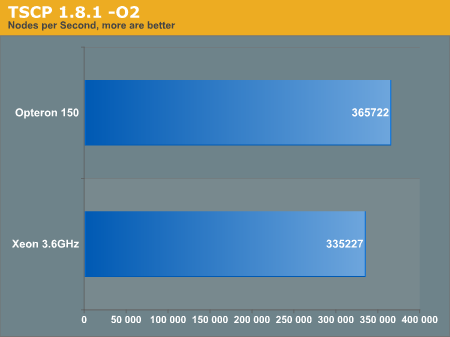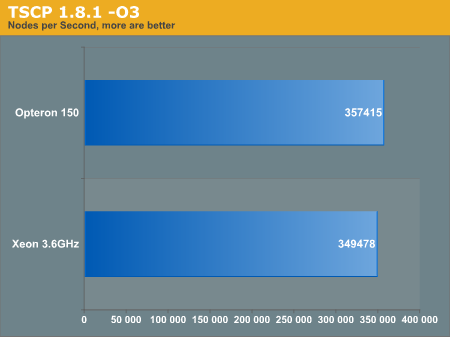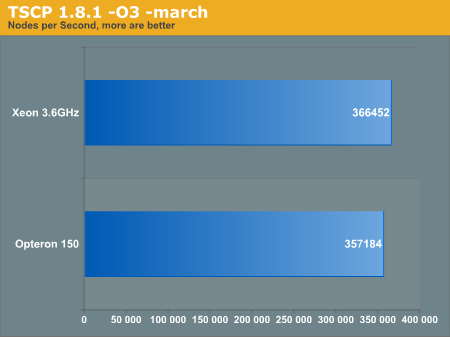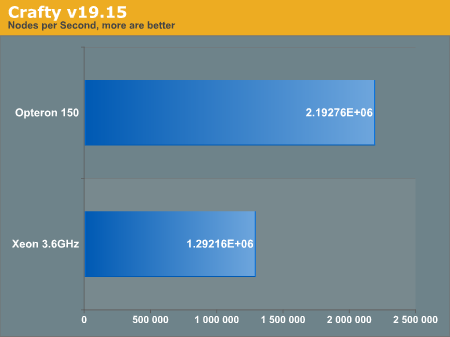Linux Shootout: Opteron 150 vs. Xeon 3.6 Nocona
by Kristopher Kubicki on August 12, 2004 2:35 PM EST- Posted in
- Linux
TSCP
We apologize for the broken TSCP Makefile in the previous review which rendered our initial results inaccurate. Fortunately we posted the file so that others were able to detect the error and not find fault with the processors instead. The large issue many of our readers have brought to our attention are the severe difference in performance between various optimizations. Below you can see how various compile flags affected our benchmark scores.
The first benchmark is run with the optimization flags:
-O2 -funroll-loops -frerun-cse-after-loop

The next benchmark is run with the optimization flags:
-O3 funroll-loops -frerun-cse-after-loop

Finally, we have the architecture optimized flags as well:
(Intel) -O3 - march=nocona -funroll-loops -frerun-cse-after-loop
(AMD) -O3 - march=k8 -funroll-loops -frerun-cse-after-loop

You are reading these charts correctly, the O3 flag actually penalizes the AMD CPU. We also compiled the program with -O2 -march=k8 but we got virtually the same score with or without the march flag.
We were informed others have been capable of much faster nodes per second using GCC 3.4.1 and the flagset:
-O3 -march=athlon-xp -funroll-loops -fomit-frame-pointer -ffast-math -fbranch-probabilities
We did not have time to fully test GCC 3.4.1, although there is a strong likelihood that 3.4 encourages better optimizations (particularly on the x86_64 platforms).
Crafty
For good measure, we have included Crafty into our chess benchmarks section. Crafty was only built using the "make linux-amd64" target. From the Makefile, it seems as though the "AMD64" moniker is slightly inappropriate. The target claims:
# -INLINE_AMD Compiles with the Intel assembly code for FirstOne(), # LastOne() and PopCnt() for the AMD opteron, only tested # with the 64-bit opteron GCC compiler.
The benchmark was generated by running the "bench" command inside the program.

It is clear the difference between both processors is quite severe in this instance. Although it is difficult to pin an exact culprit, there are likely multiple arch optimizations were left untapped, and thus our reasoning for discouraging overusage of optimizations in general.










92 Comments
View All Comments
bhtooefr - Friday, August 13, 2004 - link
Kristopher, the 150 ISN'T supposed to compete with the 3.6 Nocona. That's the 250 that does that. However, the 150 and 250 are identical, except the 250 has DP support enabled, and costs $851 - just like the 3.6 Nocona. Therefore, a 150 vs. Nocona comparison IF the Nocona is only used in a UP config is fair, even though the 150 is cheaper.Macro2 - Friday, August 13, 2004 - link
KK, it's amazing what a little parental supervision can do.DerekWilson - Friday, August 13, 2004 - link
#67 and all others with this on their minds:"Basically, all I'm saying is that it is faulty reasoning to assume that a 3.6GHz Intel cpu will be marketed against a 3500+ Amd A64 cpu."
See, there's the problem with marketing. People do see a price tag. People also two other things: a speed number and a brand.
Most people that read this site "get" that performance is more than a number, a brand, and a price tag. But the majority of the population thinks very differently.
Despite AMD's rise to the top of the CPU performance heap in many catagories, Intel is still a bigger name to the public at large.
When a random person looking for a computer sees two boxes, one with (lets say) a 3400+ and the other with a 3.4GHz pentium 4, the will absolutely feel that these products are marketed at the same target performance level. And since AMD makes up its own performance rating scheme, we would tend to agree with this assessment.
A random person sees all of this together: AMD + 3400 + low price and Intel + 3.4GHz + high price ... Based on the current state of the universe, people will generally think one of two things: the AMD system is a lower price because it is some how "cheaper" in terms of quality than the Intel system, or they'll be saving enough money that going with the AMD system is worth it. It's just psychology of people who don't know enough about what they're buying.
It is an unavoidable fact that AMD and Intel parts will be _marketed_ via their performance rating or their clock speed.
Of course, if advertising and marketing did everything in the best interest of the customer all the time, then our site wouldn't be useful. AMD could say "Buy intel if you want to do encoding" and Intel would say "buy AMD if you want to build a gaming rig" and we'd all be happy.
Honestly, general CPU marketing does not target us. We will all get together and one way or another discover the part that has the highest value. We want to know, how much performance am I getting for my dollar. We want to know how little we can spend to get the best machine we can, since it will all be obsolete in a year anyway. For this reason, we are trying to expand our CPU reviews to include more information on price/performance and value.
But since we don't assume we know performance before hand, and price is a market dicated entity, we start from marketing and go from there.
The original comparison of Nocona to the 3500+ is not an invalid comparison. At the same time, there were other issues, and it has been a learning experience for us in terms of performance testing on Linux. Granted, including a 3700+ as well would have been helpful in seeing how AMDs performance rating scales wrt Nocona preformance. The only real difference between the Nocona system and a desktop P4f 3.6 is the fact that we had to use a Tumwater board, which may or may not have had a significant impact on the performance playing feild. We'll certainly revist that question when we get our hands on a p4f (buying that Dell may be a good idea).
But, as everyone can see from the job Kris did on this latest review, we write for the readers. Price point comparisons are very doable for us, but it gets difficult before product enters the market -- which is why we don't really get hardcore about pricing out of the gates. The market does influence what happens to the price after its launch, and we like to take that into consideration.
And that's the last we'll say about that ;-)
Please continue to let us know what you guys want to see, and we will continue to deliver. Thanks for all the support and outpouring of general goodness on these comments -- Kris deserves it for putting in such hard work over his vacation.
Thanks,
Derek Wilson
Senior CPU & Graphics Editor
allnighter - Friday, August 13, 2004 - link
Thank you Kris. Much better this time around. My trust is restored. Thanks again.KristopherKubicki - Friday, August 13, 2004 - link
#72: the Nocona 3.6 and the 3.6F are going to be identical (different pin out though). I am thinking about buying a Dell just to prove it :) (You cant buy the CPU in retail yet).I sent an email out to Oracle, lets see what they say.
Kristopher
val - Friday, August 13, 2004 - link
Linux is different than windows, Windows have more overhead and more depending on frequency. Lets wait for results on Windows 64bit to judge...matman326 - Friday, August 13, 2004 - link
*Stading up and clapping*great job Kris, much better this time around(I had faith in you). But one thing trubles me about you benchmarks. I don't recall seeing any benchs on how fast you can run F@H on the puppies :)
Viditor - Friday, August 13, 2004 - link
I agree with Decoder Kris...next review, could you use the 4+ gig of ram? I'd like to see the same benches with large amounts of ram to compare...Cheers,
Charles
muddocktor - Friday, August 13, 2004 - link
I think that you did a much better article this time, Kris and not because the Opteron kicked the Xeon around pretty badly in a lot of your benchmarks. This time you compared processors that can be considered direct competitors and the comparisons do actually mean something. Kudos to you on taking the time to do the comparison right and this kind of article is what I expect to read when I come here to Anandtech. :-)CyTG - Friday, August 13, 2004 - link
MySQL and Postgres is cool ... but what about some commercial products like Oracle as well ?I'd really really like to see some numbers pished for 10g on those beasts..